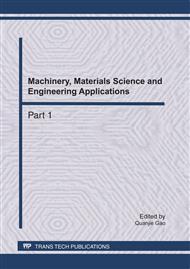p.390
p.396
p.402
p.408
p.412
p.416
p.422
p.427
p.433
Numerical Simulation and Process Optimization of the Die Forging for the Center Wedge of the Railway Freight Car Buffers
Abstract:
Aiming at the center wedge of the railway freight car buffers, the forging process was analyzed and the die design was optimized. The direct finish-forging process after pre-forming process was contrasted with the finish-forging after pre-forging based on pre-forming process, and the influence of different billet sizes and die structures on the forming were analyzed and compared. To validate the different process scheme and die structure, the numerical simulations were done using FEM software deform3D. The results show that the filling capacity of billet to die cavity increases greatly by using direct finish-forging process and finish-forging die with the resistance wall and the utilization coefficient of materials is improved. This can reduce working procedure and improve the productivity.
Info:
Periodical:
Pages:
412-415
Citation:
Online since:
April 2011
Authors:
Keywords:
Price:
Сopyright:
© 2011 Trans Tech Publications Ltd. All Rights Reserved
Share:
Citation:


